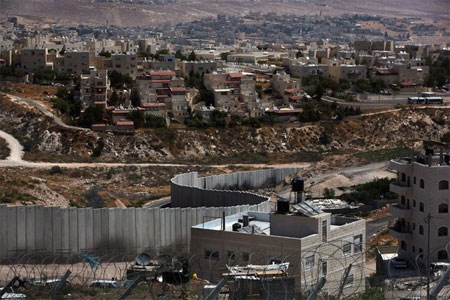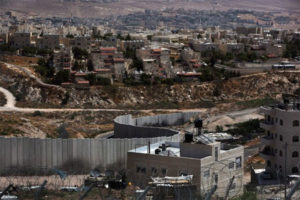The annual mission report, which is written by all the heads of diplomatic missions of EU member states in the Palestinian Authority is strongly worded and very critical of Israel’s policies in and around Jerusalem. It echoes the position on settlements in the EU Council Conclusions of December 2012, which stated: “The European Union is deeply dismayed by and strongly opposes Israeli plans to expand settlements in the West Bank, including in East Jerusalem, and in particular plans to develop the E1 area.”
The EU Heads of Mission Report 2012 on Jerusalem illustrates the EU’s concerns and opposition to Israel’s policies in and around East Jerusalem.
According to the report, Israel is “systematically undermining the Palestinian presence” in Jerusalem, through policies including “restrictive zoning and planning, demolitions and evacuations, discriminatory access to religious sites, an inequitable education policy, difficult access to health care, the inadequate provision of resources.”
Authored by EU heads of mission in Jerusalem and Ramallah, the report makes recommendations on settlements that are related to financial translations linked to or supporting Israel’s ongoing construction on occupied Palestinian land.
In a 15-page report, the EU calls to “ensure that imports of settlement products do not benefit from preferential tariffs” and make sure that all such products are clearly labelled as originating from Israeli-occupied areas.
Among others, the Heads of Mission conclude: “Settlement construction remains the biggest single threat to the two-state solution. It is systematic, deliberate and provocative. (…) Israel is actively perpetuating its illegal annexation of East Jerusalem”.
Seven of the report’s 10 recommendations deal with imposing direct or indirect sanctions by the European Union on bodies and organizations involved in construction in the settlements. The recommendation to actively encourage European divestment from the settlements is particularly severe, compared with previous internal EU reports
In its Jerusalem Report 2012, the European Union suggested member states “prevent, discourage and raise awareness about problematic implications of financial transactions, including foreign direct investments, from within the EU in support of settlement activities, infrastructure and services.”
It also warns that EU programmes should not be “used to support settlements and settlement-related activity, including funding for research, education or technological cooperation.” And it proposes member states raise awareness about “the financial and legal risks involved in purchasing property or providing services in settlements.” The consuls gave the example of Israel’s participation in a cooperative program called Horizon 2020, through which the EU invests hundreds of millions of euros in Israeli high-tech firms. Authors of the report noted that some of this funding goes to firms like the research laboratories of the cosmetics company Ahava, which are located near the Dead Sea in kibbutz Mitzpeh Shalem.
Recommendations relate specifically to Israel’s settlement policy:
- “Intensify EU efforts to counter settlement activity in and around East Jerusalem that constitutes a particular threat to the two-state solution”
- “Coordinate EU monitoring and a strong EU response in order to prevent settlement construction in E1, including opposing the forced transfer of the Bedouin community in E1”
- “Ensure strict application of the EU-Israel Association Agreement, including that products manufactured in settlements do not benefit from preferential treatment”
- “Encourage current efforts to fully and effectively implement existing EU legislation and bilateral arrangements applicable to settlement products”
- “Ensure that no EU programs are used to support settlements and settlement related activity”
- “Prevent, discourage and raise awareness about problematic implications of financial transactions, including foreign direct investment, from within the EU in support of settlement activities, infrastructure and services”
- “Inform EU citizens and companies of the financial and legal risks involved in purchasing property or providing services in settlements and recall the EU position that settlements are illegal under international law”
- “Develop and promote voluntary guidelines for EU tour operators to prevent support for settlement businesses in East Jerusalem”
- “Increase monitoring of settler violence. Individual EU Member States could explore the possibility of denying entry to known violent settlers”
Key observations and conclusions from the EU Heads of Mission Report Jerusalem 2012:
- “Israel is actively perpetuating its illegal annexation of East Jerusalem.”
- “Settlement activity damages the peace process in three ways: First, it undermines trust between the parties… Second, it jeopardises the physical prospects for creating a viable and contiguous Palestinian state… Third, it makes the compromises necessary for peace […] harder as the settlement population increases”
- “Together, these settlements [Har Homa, Gilo and Givat Hamatos] will form an Israeli buffer that once complete will virtually cut off East Jerusalem’s southern flank from Bethlehem and the southern West Bank. The construction of these three settlements is part of a political strategy aiming at making it impossible for Jerusalem to become the capital of two states. […] As these settlements grow, it will require ever more political will and capital to either evacuate them or find alternatives.”
- “Any settlement activity takes place almost invariably with the support of the government of Israel and the Municipality of Jerusalem. The short suspension of settlement activity from January until March 2012 shows that the Israeli state does have the ability to stop any settlement expansion. Similarly, the surge in settlement activity in late 2012 also was a matter of political choice […].”
- “2012 witnessed a continuation of the East Jerusalem settlement sure during 2011. Indeed, more than twice the number of tenders were issued for construction of units in East Jerusalem during 2012 (2366 new units) than were issued in the previous three years put together (a Total of 1145).”
- “If the current pace of settlement activity on Jerusalem’s southern flank persists, an effective buffer between East Jerusalem and Bethlehem may be in place by the end of 2013 thus making the realisation of a viable two-state solution inordinately more difficult, if not impossible.”
- “The implementation of the E1 project, which threatens 2300 Bedouin with forcible transfer, would effectively divide the West Bank into separate northern and southern parts. Moreover, it would prevent Palestinians in East-Jerusalem from further urban development and cut off East Jerusalem from the rest of the West Bank.”
- “The Israeli authorities have entrusted the management of the various archaeological sites in Wadi Hilweh to El’ad, a private Jewish-Israeli settler organisation. […] It is El’ad’s stated aim to transform Wadi Hilweh/Silwan into an extension of the Old City’s Jewish quarter. If completed, this plan will constitute another unilateral fact on the ground, affecting the character of the public space in this highly sensitive area.”
- The result has been a partisan historical narrative, placing emphasis on the biblical and Jewish connotations of the area while neglecting Christian/Muslim claims of historical-archaeological ties to the same place.”
- “The planning regime of the Jerusalem Municipality remains a source of concern as it places serve restrictions on Palestinian building activities, thus creating a housing shortage for the Palestinian residents as well as development constraints.”
- “Restrictive measures continue to apply in relation to the ID and residency status of Palestinians from East Jerusalem. This is linked to Israel’s demographic policy. It has been a stated aim in official planning documents to prevent the Palestinian population in East-Jerusalem from becoming more than 30 percent of the municipality’s total population.”
- “Between 1967 and 2011, Israel revoked the status of 14,561 Palestinians from East Jerusalem.”
- “The construction of the separation barrier in East Jerusalem, which started in 2002, continued throughout 2012. In the Jerusalem area, the barrier is 168 Km long, of which only three percent runs along the 1967 Green Line. The main reason behind this deviation was the integration of 12 Israeli settlements beyond the municipal boundary such as Ma’ale Adumim.”
- “The route of the barrier changes the de facto boundaries of Jerusalem and, in some cases, runs through the middle of densely populated Palestinian neighbourhoods. […] The barrier also affects at least 16 West Bank localities situation outside the Jerusalem municipal area, cutting them off from the rest of the West Bank. The 2,500 residents in these communities face impeded access to basic services and the risk of displacement.”
- “The barrier has in effect isolated East Jerusalem from the rest of the West Bank. Due to the extremely limited access the city ceased to be the traditional Palestinian economic, urban and commercial centre. The current Israeli trade regulations severely hinder import of goods and services manufactured in the rest of the Palestinian territory, particularly for the agricultural products.”
- “The loss of businesses results in lessened employment opportunities. […] The number of Palestinians in East Jerusalem living under the Israeli-defined poverty line is constantly growing (from 64% in 2006 to 78% in 2012).”
- “Although Palestinians constitute approximately 37% of the population in Jerusalem, the Municipality does not spend more than 10% of its total budget in Palestinian areas. Palestinian areas are characterised by poor roads, little or no street cleaning, limited sewage systems and an absence of well-maintained public spaces – in sharp contrast to areas where Israelis live (in both West Jerusalem and East Jerusalem settlements).”
- “A number of infrastructure/transport projects strengthen the Israeli control over East Jerusalem. The light rail which connects Israeli settlements in East Jerusalem with the centre in West Jerusalem […] began passenger service during summer 2011. A year and a half after its opening, this sensitive infrastructure remains a source of tension. […] At least three projects exemplify the Israeli authorities’ intention to consolidate the connection between major settlements and Jerusalem.”

